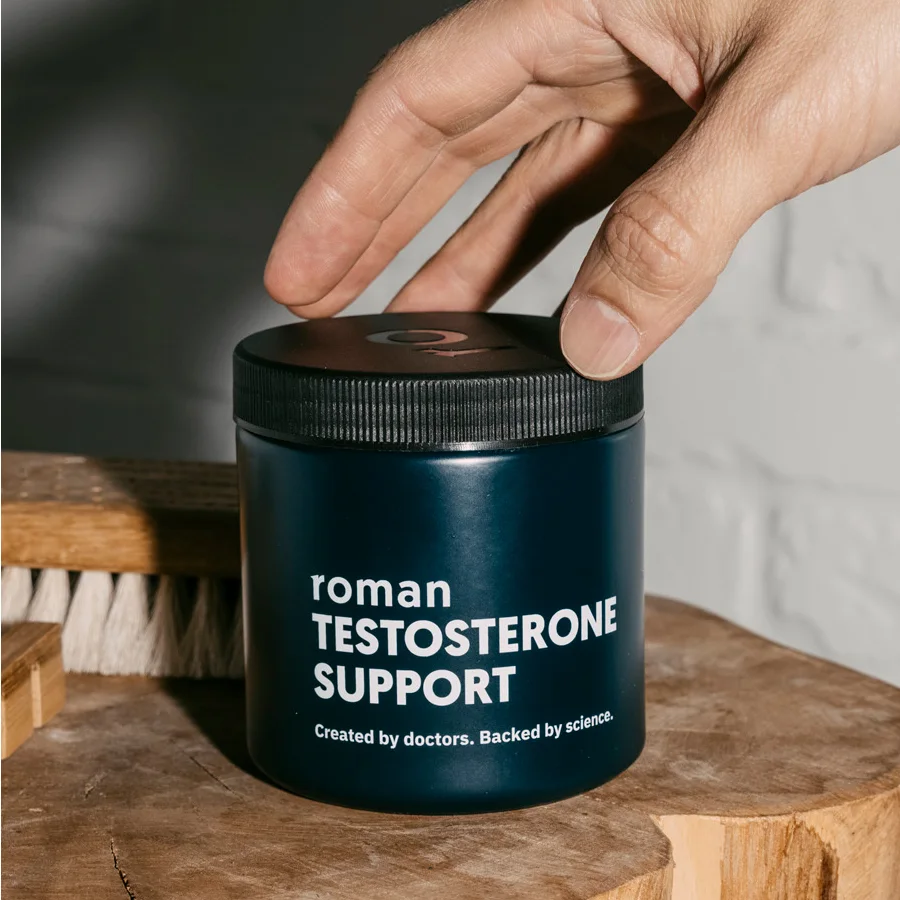Here's what we'll cover
Here's what we'll cover
If you’re wondering if you have low testosterone levels, taking an at-home testosterone test can be an easy place to start. Home testosterone tests offer convenience and privacy, but are they as accurate as lab tests? We break down what you need to know, including the pros, cons, and costs of testosterone testing at home.
How to test testosterone levels at home
We have good news. Testing your testosterone levels at home is more straightforward than you might think. All that’s required is a quick finger prick or spit test and access to a mailbox and the internet.
Home testosterone testing kits measure the amount of testosterone in your saliva or blood. When you receive a testosterone test kit, it will include instructions and equipment to collect your saliva or blood sample. For the testosterone blood test, you’ll prick your finger and drop blood into a provided receptacle. For the saliva test, you’ll spit in the included test tube or perform a swab. After collecting your blood or saliva sample, you’ll place it in a prepaid mailing package and send it to the lab. Within a few business days, you’ll be able to review your results online.
That’s the general gist of how testosterone testing at home works. The specifics and collection method will vary from brand to brand. Always read the instructions and follow them to a T (pun intended). Some test providers might offer access to on-call healthcare professionals if you have any questions, while others may have video instructions you can follow to avoid any mishaps with your sample collection.
To ensure accuracy, it’s important to collect your sample when your testosterone levels are at their highest, in the morning (Krakowsky, 2015; Mulhall, 2018). Your testosterone levels vary throughout the day and start to fall quickly after waking. For example, in a 30–40-year-old male, testosterone levels are up to 25% lower at 4 p.m. than at 8 a.m. (Trost, 2016). Some providers may also recommend fasting before taking your test, as glucose may temporarily lower your testosterone levels (Rivas, 2014).
How accurate are at-home testosterone tests?
We don’t know for sure whether at-home testosterone tests are as accurate as in-office tests. Most research into the accuracy of testosterone testing has focused on tests administered by medical professionals, not individuals at home. It is possible that an at-home test may be more susceptible to human error, for the simple reason that someone taking a test for the first time may be less likely to perform it perfectly compared with a medical professional who does it every day.
Some studies suggest that saliva testosterone tests may have more variable results, potentially producing less accurate results for women in particular (Adeboro, 2020; Welker, 2016). However, others have found that saliva testosterone tests can be just as reliable as serum (blood) tests (Keevil, 2014). Sample collection and storage may also affect the accuracy of test results (Keevil, 2014; Fiers, 2014).
Cost of a testosterone test at home
The cost of an at-home testosterone test varies from $49 to $259, depending on the brand and if it measures other hormone levels beyond testosterone, such as cortisol or estradiol. Tests that exclusively measure testosterone typically cost between $49 to $69.
To avoid surprise fees, check whether the test includes prepaid shipping for you to return your sample to the lab. Some at-home testosterone test kits also accept health savings account (HSA) and flexible spending account (FSA) payments. Finally, there’s always a possibility your insurance will reimburse you for the test. Check with your benefits provider.
How to interpret testosterone test results
Once your testosterone test results are ready, you can view them online. In general, normal morning testosterone levels for men range from 300–1,000 ng/dL (nanograms per deciliter). The normal range for young adults is between 600–900 ng/dL, while the normal range for older adults is between 500–800 ng/dL (Sizar, 2022).
The beauty of an at-home testosterone kit is that the results are often presented in easy-to-understand language, free of medical jargon. They should explain whether your testosterone levels are low, normal, or high, and recommend the next steps.
What to do if your results come back low
Schedule an appointment with your healthcare provider if your results come back low. While it is normal for testosterone levels to lower with age, they can also be a warning sign of certain medical conditions (Krakowsky, 2015). A healthcare professional can work out which is which.
During your appointment, your provider will ask about your symptoms, perform a physical exam, and may order additional tests—including another testosterone test (Mulhall, 2018). Even if you followed the instructions exactly as directed, testosterone levels can vary during the day and the week, so your provider will likely want to conduct another test to be sure (Krakowsky, 2015).
Plus, while at-home testosterone kits test your levels of free testosterone (the amount circulating freely in your blood), medical providers can order a test of your total testosterone levels. This test measures free and bound testosterone levels (the amount of testosterone bound to sex hormone-binding globulin, or SHBG) (Keevil, 2014).
What to do if your results come back normal
If your results come back normal, you may still want to consider meeting with a healthcare professional, especially if you’re still experiencing symptoms of low testosterone—such as a low sex drive or loss of muscle mass or body hair. They can order additional testing and perform a physical examination to rule out other conditions and determine what may be causing your symptoms. In all likelihood, they will order a second testosterone test to confirm your results (Krakowsky, 2015; Mulhall, 2018).
Low T treatment
Low T (hypogonadism) is common, affecting one in ten men by the time they reach their thirties (Krakowsky, 2015). There are a number of treatment options for low T, ranging from lifestyle changes to medication.
For example, smoking, drinking, obesity, and stress are all associated with testosterone deficiency (Krakowsky, 2015). Healthcare providers may recommend stopping nicotine or alcohol use, and implementing dietary changes or an exercise routine to lose weight and body fat (Kumagai, 2016). Stress is also associated with low T, so your provider may recommend stress-reduction techniques, improving your work/life balance, or getting more sleep to naturally raise testosterone levels (Krakowksy, 2015; Lo, 2018).
Medication includes testosterone replacement therapy (TRT), which can range from testosterone injections and oral medications to patches and gels you put on your skin (Krakowksy, 2015). TRT can help improve your sexual function, sex drive, and overall mood and well-being, but it does come with some potential side effects (Rivas, 2014).
If you’re concerned you might have low T, take a test to help you better understand your health and empower you to take action.
DISCLAIMER
If you have any medical questions or concerns, please talk to your healthcare provider. The articles on Health Guide are underpinned by peer-reviewed research and information drawn from medical societies and governmental agencies. However, they are not a substitute for professional medical advice, diagnosis, or treatment.
Adebero, T., McKinlay, B. J., Theocharidis, A., et al. (2020). Salivary and serum concentrations of cortisol and testosterone at rest and in response to intense exercise in boys versus men. Pediatric Exercise Science, 32 (2), 65–72. doi:10.1123/pes.2019-0091. Retrieved from https://pubmed.ncbi.nlm.nih.gov/31770720/
Fiers, T., Delanghe, J., T'Sjoen, G., et al. (2014). A critical evaluation of salivary testosterone as a method for the assessment of serum testosterone. Steroids, 86 , 5–9. doi:10.1016/j.steroids.2014.04.013. Retrieved from https://pubmed.ncbi.nlm.nih.gov/24793565/
Keevil, B. G., MacDonald, P., Macdowall, W., et al. (2014). Salivary testosterone measurement by liquid chromatography tandem mass spectrometry in adult males and females. Annals of Clinical Biochemistry, 51 (Pt 3), 368–378. doi:10.1177/0004563213506412. Retrieved from https://pubmed.ncbi.nlm.nih.gov/24194586/
Krakowsky, Y. & Grober, E. D. (2015). Testosterone deficiency - establishing a biochemical diagnosis. EJIFCC, 26 (2), 105–113. Retrieved from https://pubmed.ncbi.nlm.nih.gov/27683486/
Kumagai, H., Zempo-Miyaki, A., Yoshikawa, T., et al. (2016). Increased physical activity has a greater effect than reduced energy intake on lifestyle modification-induced increases in testosterone. Journal of Clinical Biochemistry and Nutrition, 58 (1), 84–89. doi:10.3164/jcbn.15-48. Retrieved from https://pubmed.ncbi.nlm.nih.gov/26798202/
Lo, E. M., Rodriguez, K. M., Pastuszak, A. W., & Khera, M. (2018). Alternatives to testosterone Therapy: A Review. Sexual Medicine Reviews, 6 (1), 106–113. doi: 10.1016/j.sxmr.2017.09.004. Retrieved from https://pubmed.ncbi.nlm.nih.gov/29174957/
Mulhall, J. P., Trost, L. W., Brannigan, R. E., et al. (2018). Evaluation and management of testosterone deficiency: AUA guideline. The Journal of Urology, 200 (2), 423–432. doi:10.1016/j.juro.2018.03.115. Retrieved from https://pubmed.ncbi.nlm.nih.gov/29601923/
Rivas, A. M., Mulkey, Z., Lado-Abeal, J., & Yarbrough, S. (2014). Diagnosing and managing low serum testosterone. Proceedings (Baylor University. Medical Center), 27 (4), 321–324. doi:10.1080/08998280.2014.11929145. Retrieved from https://pubmed.ncbi.nlm.nih.gov/25484498/
Sizar, O. & Schwartz, J. (2022). Hypogonadism. StatPearls . Retrieved on Sept. 20, 2022 from https://www.ncbi.nlm.nih.gov/books/NBK532933/
Trost, L. W. & Mulhall, J. P. (2016). Challenges in testosterone measurement, data interpretation, and methodological appraisal of interventional trials. The Journal of Sexual Medicine, 13 (7), 1029–1046. doi:10.1016/j.jsxm.2016.04.068. Retrieved from https://pubmed.ncbi.nlm.nih.gov/27209182/
Welker, K. M., Lassetter, B., Brandes, C. M., et al. (2016). A comparison of salivary testosterone measurement using immunoassays and tandem mass spectrometry. Psychoneuroendocrinology, 71 , 180–188. doi:10.1016/j.psyneuen.2016.05.022. Retrieved from https://pubmed.ncbi.nlm.nih.gov/27295182/










